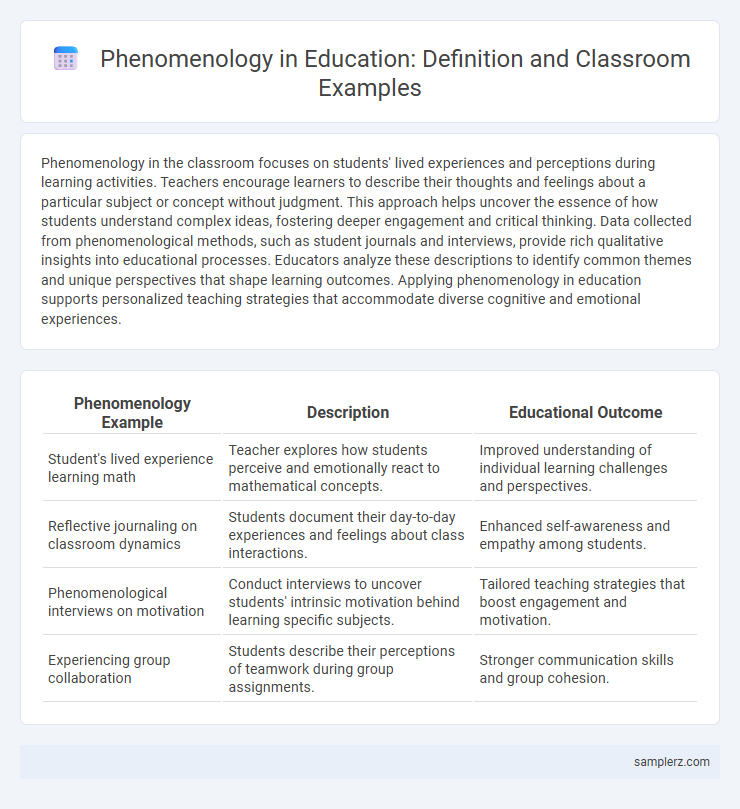Phenomenology in the classroom focuses on students' lived experiences and perceptions during learning activities. Teachers encourage learners to describe their thoughts and feelings about a particular subject or concept without judgment. This approach helps uncover the essence of how students understand complex ideas, fostering deeper engagement and critical thinking. Data collected from phenomenological methods, such as student journals and interviews, provide rich qualitative insights into educational processes. Educators analyze these descriptions to identify common themes and unique perspectives that shape learning outcomes. Applying phenomenology in education supports personalized teaching strategies that accommodate diverse cognitive and emotional experiences.
Table of Comparison
| Phenomenology Example | Description | Educational Outcome |
|---|---|---|
| Student's lived experience learning math | Teacher explores how students perceive and emotionally react to mathematical concepts. | Improved understanding of individual learning challenges and perspectives. |
| Reflective journaling on classroom dynamics | Students document their day-to-day experiences and feelings about class interactions. | Enhanced self-awareness and empathy among students. |
| Phenomenological interviews on motivation | Conduct interviews to uncover students' intrinsic motivation behind learning specific subjects. | Tailored teaching strategies that boost engagement and motivation. |
| Experiencing group collaboration | Students describe their perceptions of teamwork during group assignments. | Stronger communication skills and group cohesion. |
Understanding Phenomenology in Classroom Education
Phenomenology in classroom education emphasizes students' lived experiences and perceptions to deepen understanding of learning processes. Teachers implement reflective discussions and first-person narratives to capture subjective realities, fostering empathy and critical thinking. This approach enables learners to connect concepts with personal meaning, enhancing engagement and retention.
Real-Life Classroom Phenomenology Examples
Phenomenology in the classroom can be observed when students reflect on their individual learning experiences during group discussions, emphasizing personal perceptions and emotions. A teacher facilitates this by encouraging students to describe how they interpret a complex concept, such as historical events, from their unique viewpoints. This approach enhances deeper understanding and fosters empathy by highlighting diverse lived experiences within the learning environment.
Student Experiences: A Phenomenological Perspective
Student experiences in phenomenology focus on how learners perceive and make sense of classroom interactions and learning materials. Emphasizing personal consciousness, this approach reveals the essence of students' lived experiences, highlighting feelings, thoughts, and meanings attached to educational activities. Analyzing these experiences helps educators design more empathetic and effective teaching strategies aligned with students' subjective realities.
Teacher Insights Through Phenomenological Observation
Teacher insights through phenomenological observation reveal students' lived experiences by capturing their emotional responses, engagement levels, and social interactions during learning activities. This approach helps educators understand individual perspectives and the meaning students attribute to classroom events, enhancing instructional methods. By focusing on firsthand experiences, teachers can tailor support to diverse learner needs and promote deeper cognitive and emotional connections.
Exploring Learning Environments Phenomenologically
Exploring learning environments phenomenologically involves examining students' lived experiences to understand how they perceive and interact with the classroom space. This approach emphasizes the subjective meaning of sensory inputs, emotions, and social interactions, revealing how these factors influence engagement and comprehension. Such analysis can uncover deeper insights into motivation and cognitive processes, enhancing teaching strategies tailored to authentic learner experiences.
Classroom Discussions: Phenomenological Analysis
Classroom discussions provide a rich context for phenomenological analysis by emphasizing students' lived experiences and perceptions during knowledge exchange. This approach captures the essence of how learners interpret, internalize, and respond to ideas, fostering deeper engagement and critical thinking. By exploring subjective insights shared in dialogues, educators can better understand cognitive processes and emotional responses, enhancing pedagogical strategies.
Phenomenological Reflection on Student Engagement
Phenomenological reflection in the classroom emphasizes understanding student engagement through their lived experiences and perceptions during learning activities. Teachers observe and interpret the nuances of students' emotional and cognitive responses, fostering deeper insights into how learners connect with the material. This approach enhances instructional strategies by aligning teaching methods with the authentic experiences of student participation and attention.
Capturing Lived Experiences in Classroom Settings
Phenomenology in the classroom focuses on capturing students' lived experiences by emphasizing their perceptions, emotions, and reflections during learning activities. Teachers employ qualitative methods such as reflective journaling and open-ended discussions to understand how students interpret and make meaning of classroom interactions. This approach enriches educational research by revealing the subjective realities that shape engagement and comprehension.
Applying Phenomenological Methods in Teaching Practices
Applying phenomenological methods in classroom teaching involves engaging students in reflective discussions that explore their lived experiences related to the subject matter, such as analyzing personal perceptions during literature studies or social interactions in group projects. Teachers encourage descriptive, non-judgmental observations to deepen understanding of phenomena, fostering empathy and critical thinking through activities like journaling or experiential learning exercises. This approach enhances student awareness of their own cognitive and emotional processes, creating a more meaningful and personalized learning environment.
Benefits of Phenomenological Approaches in Classrooms
Phenomenological approaches in classrooms enhance students' engagement by focusing on their lived experiences and individual perspectives, fostering deeper understanding and empathy. These methods promote critical thinking and self-reflection, encouraging learners to connect theoretical concepts with personal meaning. Research shows that phenomenology-based teaching improves emotional intelligence and creates a more inclusive, student-centered learning environment.

example of phenomenology in classroom Infographic
 samplerz.com
samplerz.com